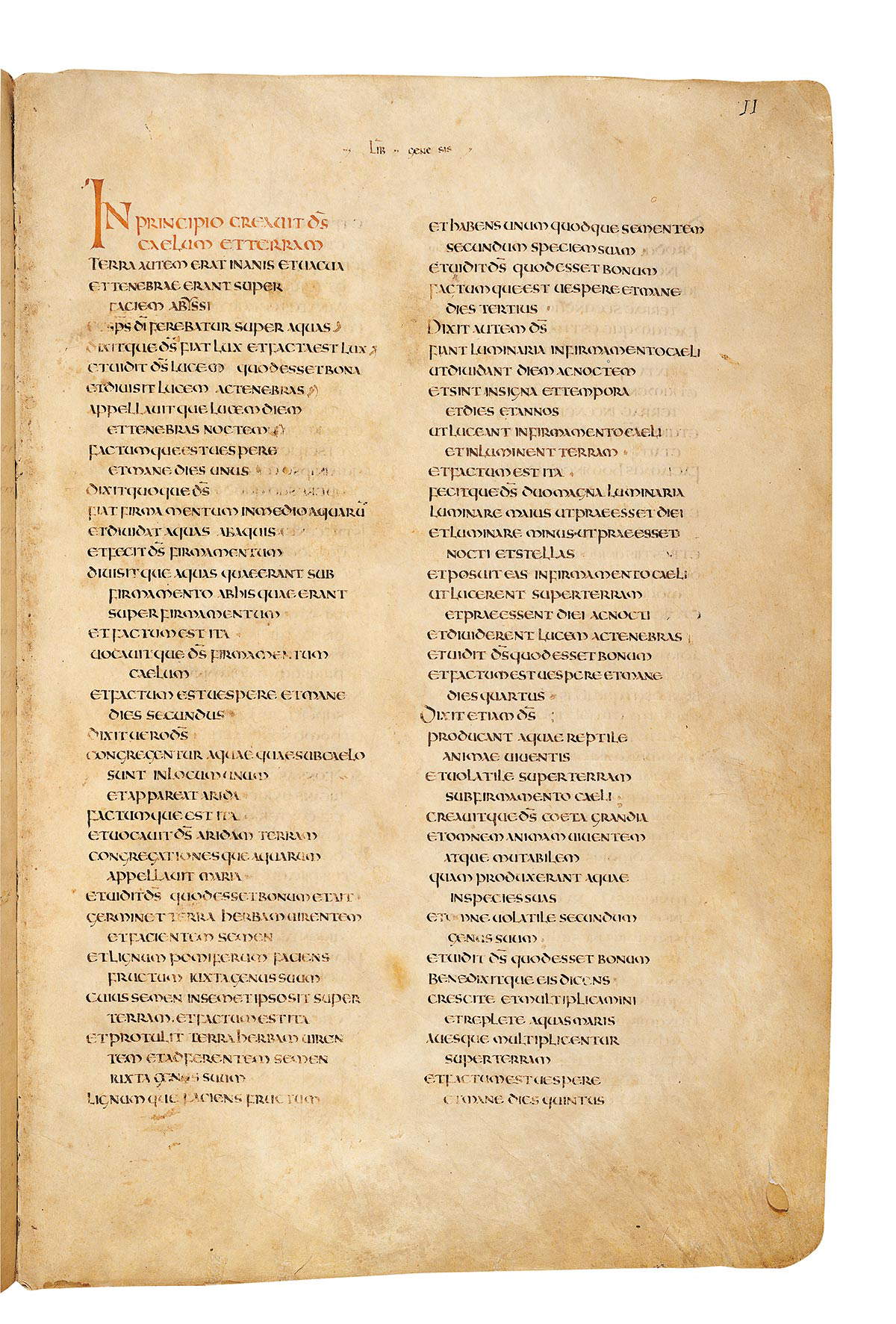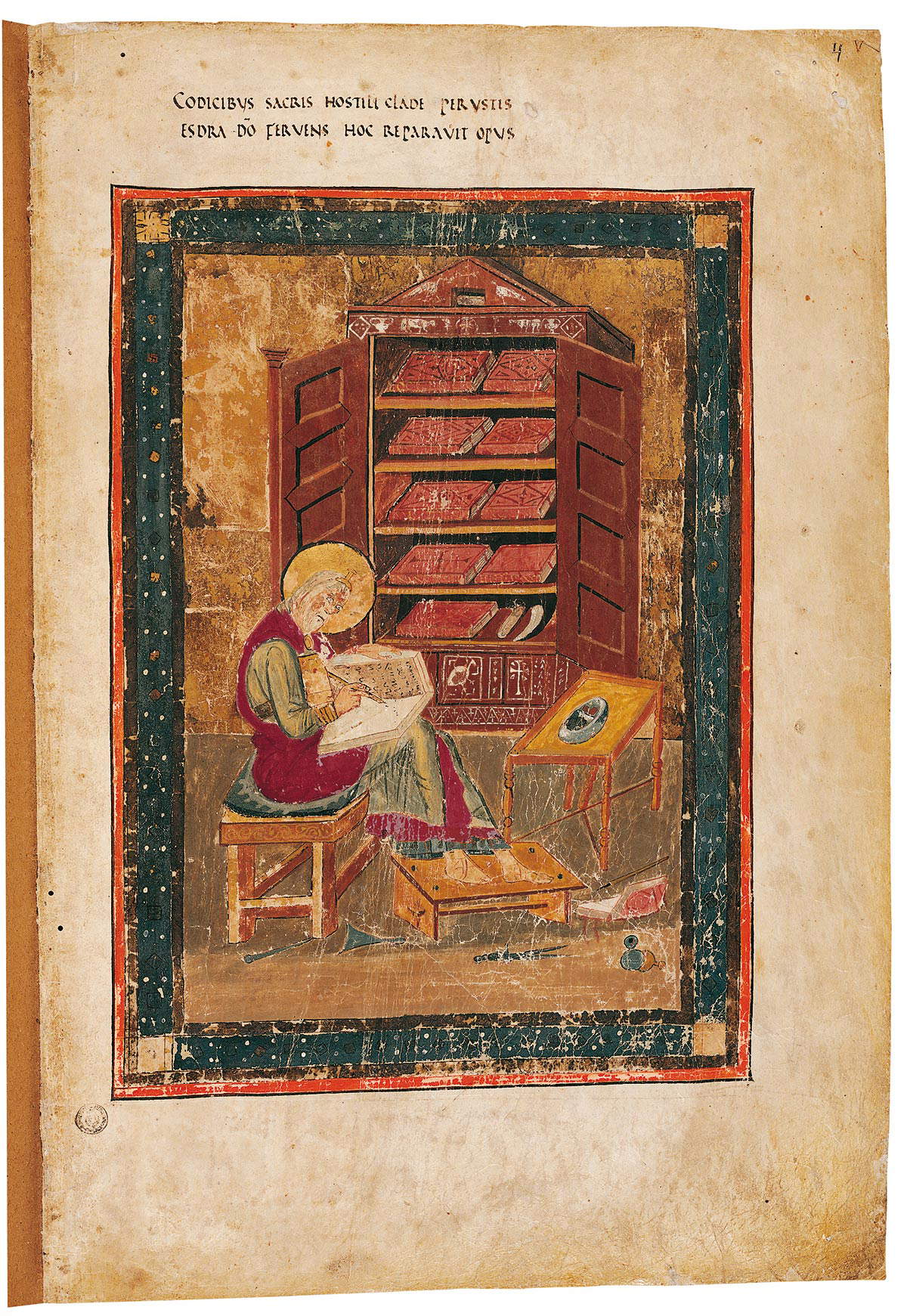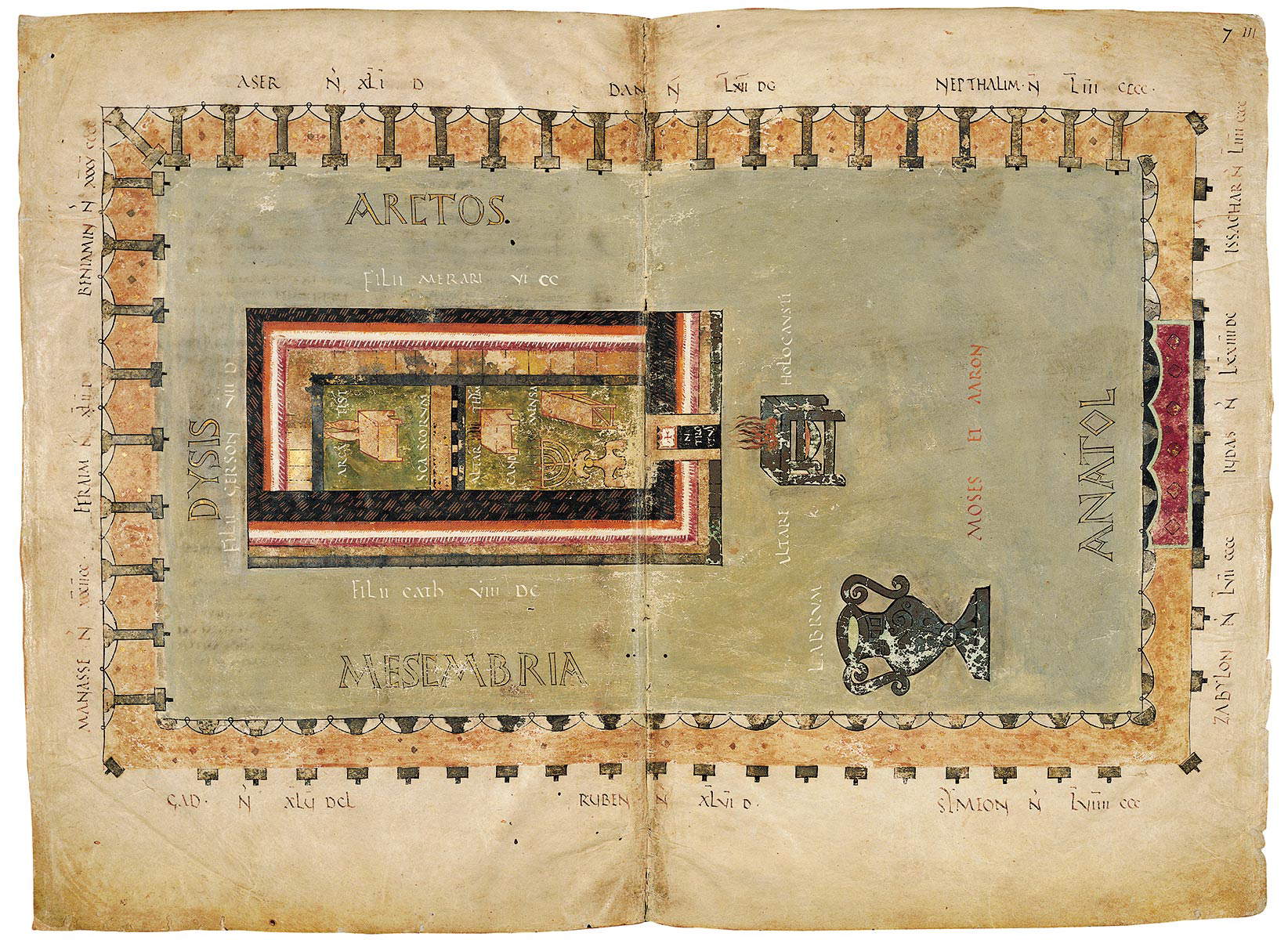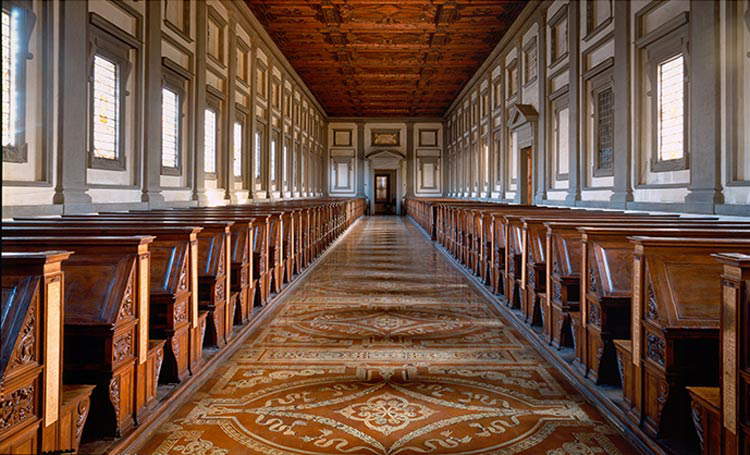The Amiatine Bible, the oldest copy of the Scriptures in the Latin version by St. Jerome
One of the most important manuscripts for the study of the Holy Scriptures is in the Biblioteca Medicea Laurenziana in Florence: it is the Amiatine Bible (also known as Codex Amiatinus), a codex that was produced in the monasteries of Wearmouth-Jarrow, Northumbria (a region in northeastern England), at the behest of Abbot Ceolfrith (c. 642 - 716), who commissioned the production of three Bibles modeled on an ancient volume that was most likely purchased in Rome around 679-680. Of these three Bibles commissioned by Abbot Ceolfrith, the Laurentian manuscript, which was probably intended as a gift to be sent to Pope Gregory II for St. Peter’s Basilica, is the only one that has survived in one piece. The work did indeed reach Rome, but it remained there for only a century: it was in fact then transferred to the Abbey of San Salvatore on Mount Amiata, in Tuscany (hence the name by which it is known today), where it remained until the eighteenth century when, following the Leopoldine suppressions (ordered by Grand Duke Peter Leopold of Lorraine), the monastery’s holdings were taken elsewhere and the Amiatine Bible took the road to Florence. Thus, since 1785, the Codex has found a home in the Biblioteca Medicea Laurenziana.
There are many interesting aspects of this extraordinary codex, compiled between the end of the seventh and the beginning of the eighth century: meanwhile, it presents itself with dimensions out of the ordinary since it consists of 1,029 membranous papers, that is, of parchment (about 500 sheep were needed to put the material together), it measures 540 by 345 by 253 millimeters, it weighs over 50 kilograms and it required the employment of eight copyists to make it. It is precisely these imposing dimensions, which necessarily make it very uncomfortable to consult (it will then be necessary to consider that a ban on its use was imposed for a long time), that have ensured that the Amiatine Bible has arrived to the present day, despite its approximately 1,400 years of life, in excellent condition (if, however, one does not consider the binding, which underwent several revisions).
However, the main reason why the Amiatine Bible is an extremely interesting codex lies in the fact that it is the oldest and most complete witness to the most widely used Bible in Latin, the so-called Vulgate, i.e., the translation into the language of Rome made at the end of the fourth century by St. Jerome (it is so called from the Latin expression vulgata editio, literally “edition for the people”). Jerome wrote it on the basis of the Greek translation from the Hebrew of the Septuagint (an ancient version of the Old Testament in Greek), composed between the third and second centuries B.C., and revised some time later by the great theologian Origen (c. 185 - c. 254), one of the leading Christian writers of the first three centuries, who was also director of the Catechetical School of Alexandria.
The copyists who attended to the creation of the Amiatine Bible performed careful and rigorous work: this is understood from the fact that for the drafting of the codex the Wearmouth-Jarrow monks took several models as references, including the most up-to-date and the most antiquated ones, so that they could draft a text that was not only valuable, but also modern, functional for reading, and capable of taking into account the many traditions that were in circulation at the time. Scholars in particular have noted that the main model for the Amiatine Bible is the Codex grandior produced by the Calabrian monastery of Vivarium, near Squillace, and made to be copied by Cassiodorus (c. 490 - 583): this manuscript, now lost, followed Latin versions of the Holy Scriptures drafted by St. Jerome himself after 387 (the Vulgate was instead produced around 393). The main difference that separated Codex grandior from Codex Amiatinus lies precisely in the fact that the Bible made in England belongs to the Vulgate recension.

 Codex
Codex
The importance of this codex, written in oncial type on two columns per page and with 43 or 44 lines per column (it is also one of the best examples of this spelling), is also linked to theillustrative apparatus of the first fascicle. “In addition to the purple paper containing the Prologue, which highlights its qualitative value, and the one containing the dedication verses, the reading of which was first clarified [...] by Giovanni Battista De Rossi, based on paleographic analysis and reading of the preserved sources,” wrote scholar Francesca Arduini, director of the Laurenziana from 1996 to 2009, “there is a full-page miniature depicting the Jewish scribe and priest Ezra copying or rewriting from memory the destroyed Bible. This is certainly one of the most famous images in the world among those found on codices and one of the most reproduced images ever. In fact, Ezra or perhaps Cassiodorus - according to other interpretations - is depicted there in the act of writing, surrounded by the tools of the Late Antique scriptorium that are at his feet, while in the background is depicted a library, or rather the armarium in which the codices are placed horizontally on the planes.”
We know important details of the history of the Amiatine Bible precisely because of the annotations that scholars have found between its pages: the aforementioned dedication verses, which unequivocally certify the commission by “Ceolfridus Anglorum,” or Abbot Ceolfrith, were later corrected to be updated with information about the new place of storage of the Bible. The dedication verses, discovered as reported above by epigraphist Giovanni Battista De Rossi in 1888, read: “Corpus ad eximii venerebile Petri / Quem caput ecclesiæ dedicat alta fides / Ceolfridus Anglorum extremis de finibus abbas / Devoti affetti pignora mitto” (“To the body of the most venerable Peter / To whom the head of the church is consecrated by high faith / Ceolfrith abbot of the extreme borders of the English / I send a pledge”). The word “Corpus” was replaced with “Cenobium,” “Petri” with “Salvatori,” and “Ceolfridus Anglorum” with “Petrus Langobardorum” (indeed there was a Peter abbot of St. Savior’s after 886, although at that time the rule of the Lombards in Tuscany had ended). The only certainty we have is that certainly in 1035 the Bible was at San Salvatore, even if it was brought there before this date, and from there it would not move again until the time of Peter Leopold’s conventual suppressions, except for a trip to Rome made between 1587 and 1591: the Amiatine Bible was in fact considered so important that it was used as the basis for the Sisto-Clementine edition of the Vulgate published in 1592. This was the only authorized Latin version of the Bible after the Council of Trent. We know this because on the verso of the second guard sheet (guard sheets are those between the binding and the printed book) is a note that reads, “La presente Bibia A dì 12 di luglio 1587 fu portata al illustrissimo Card. Antonio Carafa for the work of the emendatione della Bibia latina vulgata by order of His Holiness Sixto v in Rome and was returned on dì 19 di gennaro 1592 alli Reverendi Padri D. Marcello Vanni et D. Stefano Bizzotti Monaci di Monastero di S. Salvatore in Montamiata. I Arturo de’ conti d’Elci.”
Between 1999 and 2000, the Amiatina Bible underwent a number of important operations that enabled the creation of faithful reproductions: an undertaking that was not easy (in order to make images of the folios, it was necessary to unhide the codex), but which also made diagnostic investigations of the manuscript feasible (by which, for example, it was possible to ascertain that it was written on parchment), and above all made it possible to make several “derivative” copies that allow the codex to be studied accurately without the need to touch the original. One of these copies, in full size, reached the Museum of the Abbey of San Salvatore on the occasion of the Jubilee of 2000, thus sanctioning a symbolic return of the Amiatine Bible to the place that for long centuries preserved it with such care.
The Laurentian Medici Library
Born from the collections of the Medici family of Florence, the Biblioteca Medicea Laurenziana occupies the premises that are located next to the basilica of San Lorenzo (hence the name) and were designed by Michelangelo Buonarroti. Today, in fact, people also visit the Laurenziana to appreciate its wonderful interiors, which were later remodeled: famous is the Scalone in pietra serena designed in 1559 by Bartolomeo Ammannati. The Laurenziana holds one of the world’s leading collections of manuscripts (there are over 11,000 manuscripts preserved here and the Amiatine Bible is one of its most precious treasures), and then again over 68,000 printed volumes, 406 incunabula, 4,058 cinquecentine. Among the most valuable objects that the Laurenziana houses are codices containing the works of ancient authors such as Tacitus, Pliny, Aeschylus, Sophocles, Quintilian, and then again the Virgil corrected in 494 by Turcius Rufius Apronianus Asterius, the oldest witness to Justinian’s Corpus Iuris Civilis, which was copied shortly after its promulgation.
The Laurenziana also preserves the Fondo Mediceo, consisting of about 3.000 manuscripts that belonged to the Medici (63 of which were by Cosimo the Elder: among them three complete collections of the Platonic Dialogues in carta bona, given by Cosimo il Vecchio to Marsilio Ficino so that he him to translate it), manuscripts from the convent of San Marco, the precious Squarcialupi codex (the only source of secular music between the 14th and 15th centuries), some autographs of Petrarch and Boccaccio, Guicciardini’s Histories with interventions by the author and the partly autograph biography of Benvenuto Cellini, the autographs of Vittorio Alfieri, the D’Elci collection containing 1.213 specimens of princes’ editions of authors of Greek and Latin antiquity, the approximately 2,000 medieval codices that belonged to Lord Ashburnam.
The Biblioteca Medicea Laurenziana is then one of the main places of study of the Florentine Renaissance, given the presence of many works by the most important humanists, as well as the codices they owned: it is possible to mention among others Pico della Mirandola, Marsilio Ficino, Coluccio Salutati, Poggio Bracciolini, Niccolò Niccoli. The Laurenziana is also a place of preservation of important illuminated codices of the Renaissance, with illustrations inspired by the masterpieces of such masters as Cimabue, Botticelli, Antonio and Piero del Pollaiolo, and Domenico del Ghirlandaio. Precisely because of an exceptional record based on two factors (the uniqueness of the collections and the nature of the building designed by Michelangelo), the Biblioteca Medicea Laurenziana is not only one of Italy’s most important state libraries, but is a monument that tells an important part of the history of world culture.

Warning: the translation into English of the original Italian article was created using automatic tools. We undertake to review all articles, but we do not guarantee the total absence of inaccuracies in the translation due to the program. You can find the original by clicking on the ITA button. If you find any mistake,please contact us.




























